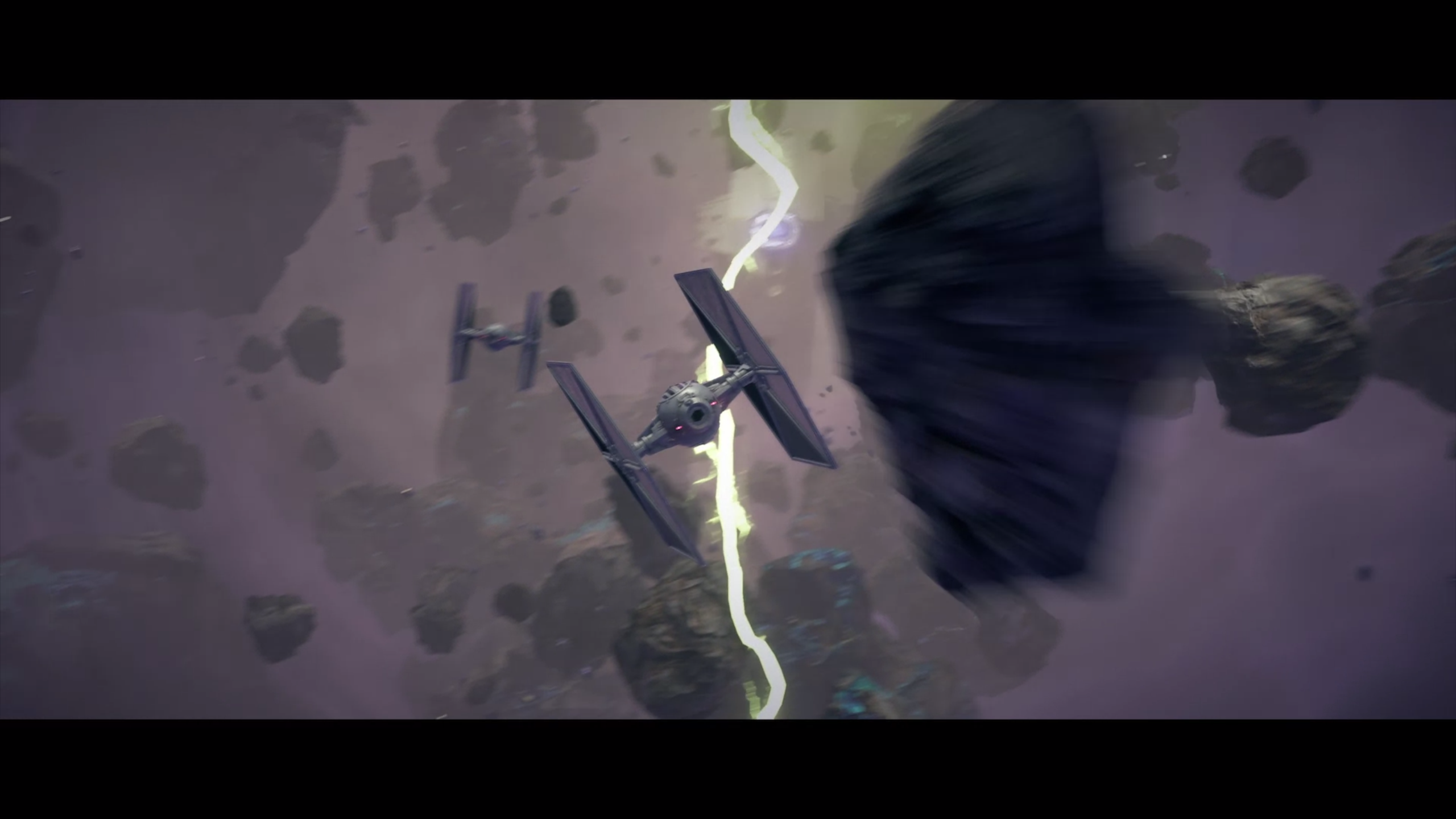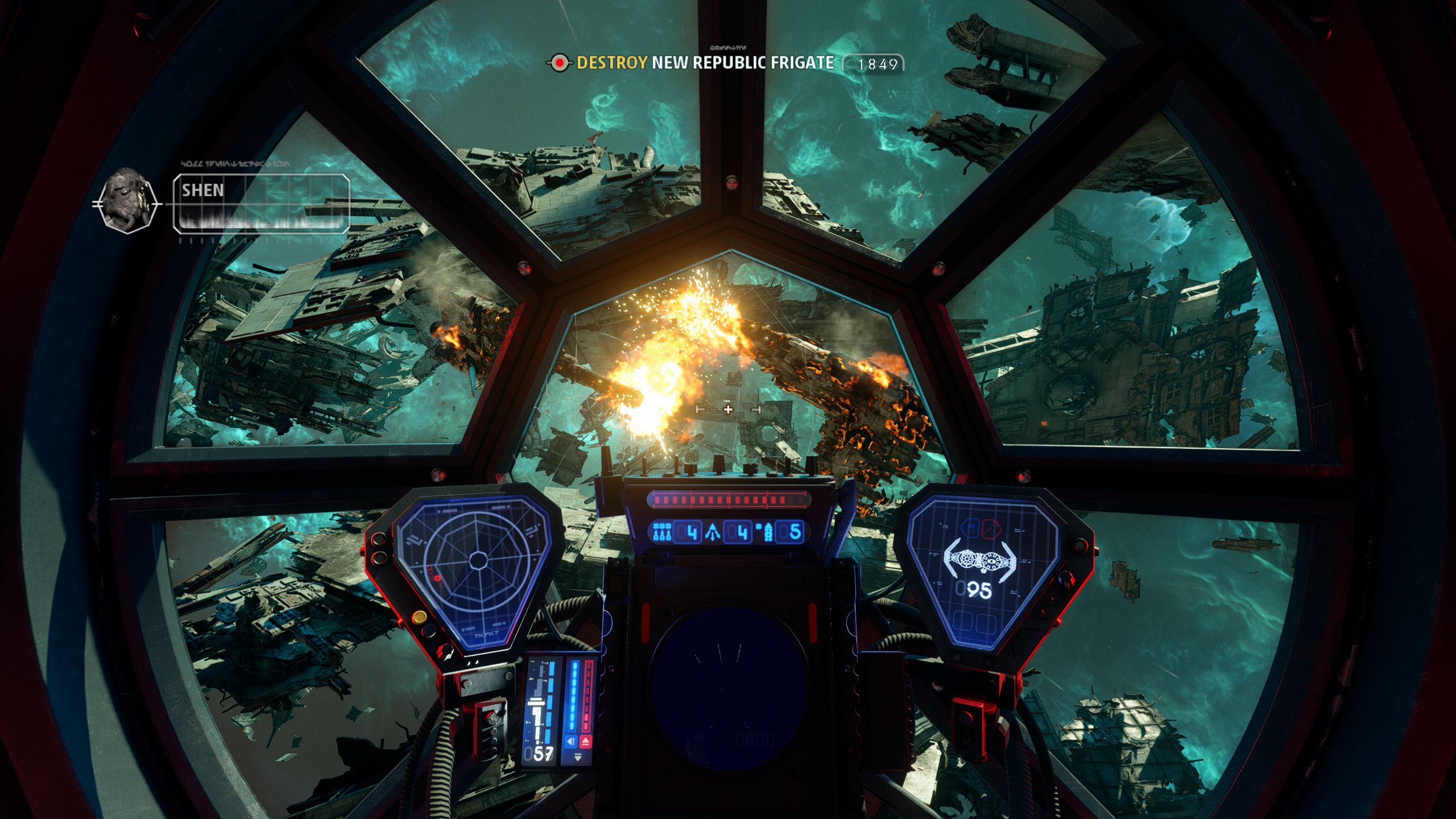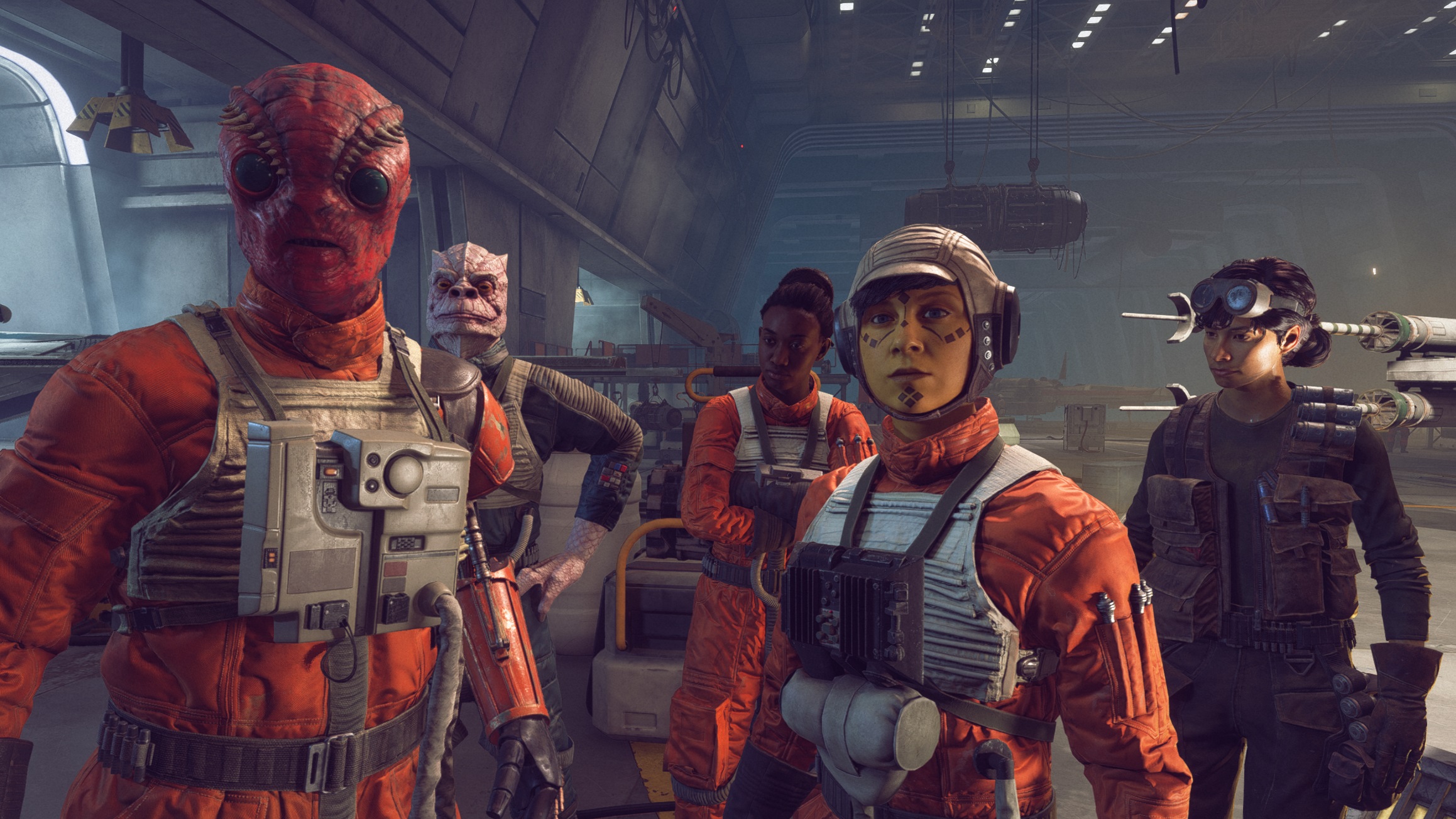Our Verdict
Star Wars: Squadrons delivers on great dogfighting, even when its campaign doesn't live up to its full potential.
PC Gamer's got your back
Hot damn, do I love an A-Wing. Until Star Wars: Squadrons, the speed demon of the Rebellion was never my favorite ship. Years of my life spent playing Rogue Squadron made me an X-Wing diehard, and even when I first played Squadrons on a controller, I didn't appreciate the joy of piloting what's basically an aluminum foil cockpit attached to an oversized engine. But when I hooked up the HOTAS, the A-Wing made me forget how much Rise of Skywalker had drained my enthusiasm for all things Star Wars.
What is it? Space dogfighting action.
Expect to pay £35/$40
Developer EA Motive
Publisher EA
Reviewed on GTX 1080, Intel i7-7700K, 16GB RAM
Multiplayer Yes
Out October 1
Link Official site
Star Wars: Squadrons succeeds where it's most important. It's a thrill to pilot these ships a hair's breadth above the surface of a Star Destroyer, and through stunning nebulae and war wreckage more vivid than I could've possibly imagined while playing TIE Fighter in the late 1990s. The campaign, which took me about 10 hours to complete on the default difficulty, never really surprises, but it does manage to accomplish something noteworthy: This feels like being in Star Wars in a way no game has in a long, long time.
The flying in Star Wars: Squadrons is exactly what I hoped for. It's a flight model far simpler than an Elite Dangerous or Microsoft Flight Simulator, but there's enough nuance to let skilled pilots excel. The central system for both factions' four ships is power management, just like in the classic X-Wing games. Over the course of the campaign I started to get a feel for exactly when to cut the throttle to make a tight turn, when to flick all my power to weapons to lay on the damage, and how to survive by focusing my shields to the rear to take a few more hits from an enemy on my tail.
The campaign teaches you most of these advanced moves slowly as a primer for multiplayer, which EA hopes you'll keep coming back for. There's a progression system, but it's refreshingly simple compared to most games in 2020. There's no battle pass or premium currency here—you simply play multiplayer matches, rank up, and use your rewards to unlock cosmetics and additional ship components. Those unlocks are nice, but I mostly want to keep playing Star Wars: Squadrons because it's so fun to fly.
Protect your battleship
If Squadrons' singleplayer is drinking a nice warm cup of Star Wars tea, its 5v5 multiplayer is slamming a Red Bull. Human opponents are much more alive (and much harder to hit) than the campaign's AI fighters. I found myself gripping my joystick more tightly and leaning in, far more focused on the action.
Squadrons keeps multiplayer lean with only two modes: dogfights (aka deathmatch) and Fleet Battles, which are tug-of-war contests between two enemy capital ships. If you destroy enough of the enemy team's fighters, you can push forward on the offensive, defeating two medium-size cruisers before tackling the Imperial Star Destroyer or Republic MC75. Fleet Battles are great play spaces because they demand some strategy, but still allow for plenty of flexibility—they provide structure to dogfights that give moment-to-moment victories more meaning.
They also force you to make decisions more complex than picking the fastest ship for a dogfight. You can pilot a heavy bomber and focus on dealing big damage to those capital ships, but you'll need teammates in nimbler craft, like the A-Wing or TIE Interceptor, to take down enemy fighters. Imperial teams really need a support ship, which can provide them temporary shields, to stick it out in longer battles against the New Republic. Ship customization plays into this well: Ion cannons can take down shields quicker than lasers, while certain high damage missiles are ideal against capital ships but can only be fired from long range.
Keep up to date with the most important stories and the best deals, as picked by the PC Gamer team.
With a team of random players there's only so much coordination you can do, but Squadrons lets you swap ships mid-match to suit the moment, and there's also a ping system for calling out targets. I've played enough of Fleet Battles to feel confident that it's a mode people will keep playing and develop more tricks for, with Discord groups planning out their exact ship selections and arsenals to complement each other like MOBA players before a match.
The highlight of my time with multiplayer was playing dogfight mode with a full team of PC Gamer editors, as we got better at pinging targets and shooting enemies off one another's tails. That experience amplified the fun of simply juking an enemy or nailing a TIE Fighter with a perfect laser blast—which is saying something, because the core flying in Squadrons is exhilarating. When I weave through the cracks of an asteroid field to dodge a homing torpedo, it's hard not to let out a Han Solo whoop.
Many times while reviewing this game I had moments like that—moments that felt like full-on Star Wars immersion because they let me act out my own bursts of action that delivered the same excitement as the movie space battles. I'll take that over another version of the Battle for Hoth any day.
Playing in VR makes that feeling even more intense, and even gives you some advantages. You can look all around your cockpit and stare straight up to see the ship you've been flying in circles trying to catch. I found it overwhelming (and nauseating, on the Oculus Quest) to pitch and roll my ship through these dogfights, and think it's a better fit for campaign's staged battles than the mad pace of multiplayer. I was initially worried that the campaign would just be a glorified tutorial, but it's both more fun and more interesting than I expected.






Star tours
In the cockpit, this is probably the best a Star Wars flight game has ever felt
One mission early in the campaign had me attacking a Star Destroyer as Vanguard Squadron, but instead of destroying it as I would in multiplayer, I was trying to capture it. I had to take down its defenses, puncture a hole to the bridge, and then defend it from other Imperial ships while a commando squad took control of the ship. In another, I escorted some weaker ships as bait to lure the Empire into a trap. Keeping your capital ships alive is forgiving on the standard difficulty, so escort missions are, miraculously, actually fun.
It helps tremendously that this game is so scenic and takes full advantage of scale to make you feel tiny in your cockpit. I kept trying to grab screenshots of enormous planetary backdrops, the dockyards and space stations and debris fields that anchor each map and keep you from getting lost in the void of space. Squadrons also runs flawlessly on my PC: at over 144 fps on ultra settings on an i7-7700K and a GTX 1080 (okay, occasionally it dipped into the 130s. I can live with that).
Even when the campaign missions aren't especially complex, the setting makes up for it. The moments that felt the most thrillingly Star Wars weren't scripted into the story, but of my own making—when I chose to fly through the husk of an old cruiser to shake a missile, then came back out behind an enemy TIE and shot it to pieces.
These missions don't have many scripted "setpiece" moments, and I'm glad that the game uses them sparingly and refrains from taking control away from you too often. Squadrons recognizes that the fun mostly lies in being at the controls, successfully tossing power to engines and making a corkscrew turn to get behind the ship that was just on your tail. But it does end up feeling all a bit routine, by the end. Objectives don't really change mid-mission. You set out to X, you do X, and that's a wrap. There are a few rare secondary objectives, but they don't add different ways to accomplish a mission, or secrets to uncover.
Star Wars: Squadrons is a game with memorable moments rather than memorable missions. The story never guided me through something as thrilling and unforgettable as Titanfall 2's Effect and Cause, for example, but I'll remember piloting an X-Wing upside-down along a Star Destroyer's hull more vividly than any individual shootout in that game.
The story, too, lacks the depth needed to be truly memorable. It alternates between the New Republic and Imperial perspectives, putting you in the boots of the new fifth pilot in the Republic's Vanguard Squadron and the Empire's Titan Squadron. Vanguard's commander is an Imperial defector who led Titan before the destruction of Alderaan made him realize they were the baddies. The setup makes this story more personal than political, as Titan's new leader, Terisa Kerrill, feels betrayed by her former mentor and wants to make him suffer. It turns out fascists really hold a grudge.
Star Wars: Squadrons never does much with its characters, though, and that's a real shame, because I wanted to be friends with each alien on sight. Their designs are imaginative and detailed, putting Star Wars species we rarely see front and center. But Squadrons seems more concerned with adding your commanders and fellow pilots to the Star Wars canon than giving them any growth or resolution. And it has nothing new to contribute to the Empire vs New Republic dichotomy, with every monologue about a pilot's allegiance boiling down to "Freedom and hope!" or "Power is good, Rebels are scum!" I don't mind a straightforward good guys/bad guys story if character growth is the focus, but they never really get a chance to shine.
Between each mission, I'd spend five or 10 minutes talking to members of my squad—or rather, listening to them monologue, literally (and stiffly) delivering their backstory directly to the camera.
There's so much potential here. Take Gunny, squad leader of Vanguard, who's been a pilot so long she fought in the Clone Wars. She tells the story of being shot down and having to take off her own arm to escape the wreckage and capture. Or Shen, a very one-note (but very entertaining) TIE pilot who's been wounded in so many battles he never takes off his helmet to unveil the horrible scarred face beneath. I enjoyed getting to know these characters at first, but grew bored of the conversations between missions when it was clear none of them would really change throughout the campaign.

There are zero dialogue options, decisions, or ways to express or shape your own pilot's role in this story. Squadrons made me realize how meaningful even simple dialogue options are for bonding with your crew in games like Mass Effect. This is a shallow reflection of that experience, and it's disappointing you can't have any real interaction with your squadron.
At one point smuggler-turned-Rebel-pilot Frisk, a lizardy Trandoshan, mentions playing sabacc, the Star Wars version of poker. I spent the rest of the game imagining an alternate universe where Squadrons had a sabacc minigame and let me play cards like in Star Trek: TNG. If Squadrons is a success, I hope the sequel has the budget to be more ambitious with its singleplayer. I want more to do between missions than listen to monologues.
In the cockpit, though, this is probably the best a Star Wars flight game has ever felt, and that's a real feat for the spiritual successor to some truly beloved games. It deserves to be the start of a new era of Star Wars flight sims with at least a big enough budget to fit a B-Wing into the next one.
Star Wars: Squadrons delivers on great dogfighting, even when its campaign doesn't live up to its full potential.

Wes has been covering games and hardware for more than 10 years, first at tech sites like The Wirecutter and Tested before joining the PC Gamer team in 2014. Wes plays a little bit of everything, but he'll always jump at the chance to cover emulation and Japanese games.
When he's not obsessively optimizing and re-optimizing a tangle of conveyor belts in Satisfactory (it's really becoming a problem), he's probably playing a 20-year-old Final Fantasy or some opaque ASCII roguelike. With a focus on writing and editing features, he seeks out personal stories and in-depth histories from the corners of PC gaming and its niche communities. 50% pizza by volume (deep dish, to be specific).


